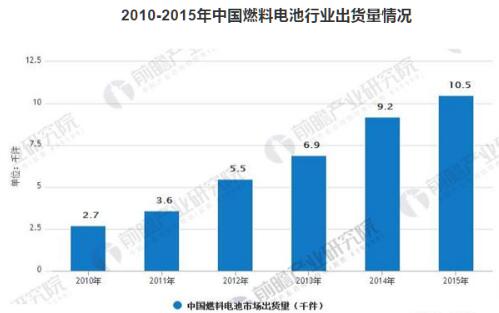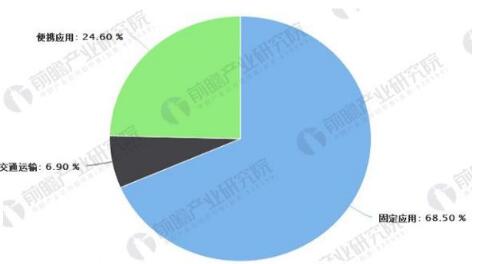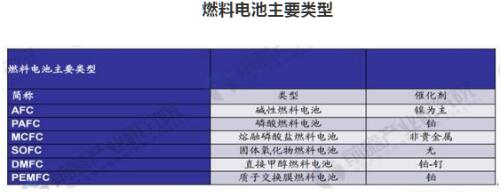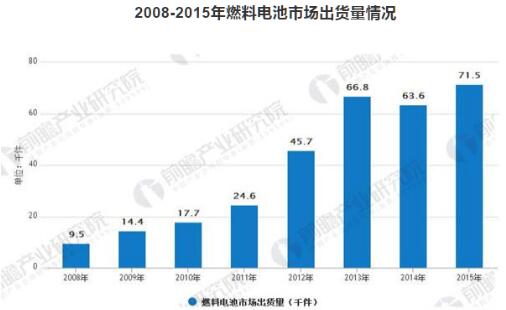A fuel cell is a power generation device that directly converts the chemical energy of a fuel and an oxidant into an electrical energy through an electrochemical reaction. It is mainly composed of positive electrode, negative electrode, electrolyte and auxiliary equipment. Common fuels include hydrogen, methanol, hydrazine, hydrocarbons, and carbon monoxide. The oxidant is generally oxygen or air. Electrolytes are commonly found in phosphoric acid, potassium hydroxide, molten carbonates, and ion exchange membranes.
A fuel cell is a power generation device that directly converts the chemical energy present in the fuel and oxidant into electrical energy. Unlike conventional internal combustion engines, the chemical energy in the fuel is not burned, but released through an electrochemical reaction, which has the advantage of high efficiency and zero emissions. Fuel cells are mainly classified into six types, among which PAFC, DMFC, and PEMFC use platinum metal catalysts.
The main type of fuel cell
2008-2015 Fuel Cell Market Shipment
Chinese fuel cell industry shipments during 2010-2015

Divided by application areas, fixed-use fuel cell shipments accounted for 68.5% of total shipments in 2015, reaching 49 thousand; portable application shipments accounted for 24.6%, reaching 17.6 thousand; shipments in the transportation industry accounted for 6.9% was 4.9 thousand. Among them, Asian fuel cell shipments in Asia accounted for 65.2% of global shipments in 2015, reaching 46.6 thousand; North American fuel cell shipments accounted for 22.0%, reaching 15.7 thousand; European shipments accounted for 11.6%, reaching 8.3 thousand. Pieces.
International Fuel Cell Regional Structure in 2015 (Shipment by Application Area)

A fuel cell is a power generation device that directly converts the chemical energy present in the fuel and oxidant into electrical energy. Unlike conventional internal combustion engines, the chemical energy in the fuel is not burned, but released through an electrochemical reaction, which has the advantage of high efficiency and zero emissions. Fuel cells are mainly classified into six types, among which PAFC, DMFC, and PEMFC use platinum metal catalysts.
The main type of fuel cell

Global Fuel Cell Development Status
The global fuel cell market is developing rapidly. According to the “Future Cell Market Prospects and Investment Strategic Planning Analysis Report” released by Industry Research Institute, the data show that in 2008 global fuel cell shipments were 9.5 thousand, and fuel cell shipments in 2015 It reached 71.5 thousand, which is 7.5 times that of 2008.
2008-2015 Fuel Cell Market Shipment

Chinese fuel cell industry market size
In 2015, Chinese fuel cell industry shipped approximately 10.5 MW, an increase of 14.13% from 9.2 MW in 2014.
Chinese fuel cell industry shipments during 2010-2015

International fuel cell regional pattern
Divided by application areas, fixed-use fuel cell shipments accounted for 68.5% of total shipments in 2015, reaching 49 thousand; portable application shipments accounted for 24.6%, reaching 17.6 thousand; shipments in the transportation industry accounted for 6.9% was 4.9 thousand. Among them, Asian fuel cell shipments in Asia accounted for 65.2% of global shipments in 2015, reaching 46.6 thousand; North American fuel cell shipments accounted for 22.0%, reaching 15.7 thousand; European shipments accounted for 11.6%, reaching 8.3 thousand. Pieces.
International Fuel Cell Regional Structure in 2015 (Shipment by Application Area)

The future direction of fuel cell industry
Fuel cell technology is the best alternative to internal combustion engine technology and represents the future direction of automotive development. However, if several constraints on the development of fuel cell vehicles are taken into account, it will be found that fuel cell vehicles are not yet ready for commercialization at this time and in the future. The most optimistic forecast predicts that commercial production of pure hydrogen fuel-based fuel cell vehicles will require at least 15 years of time. Even if commercialization is achieved to some extent, it will be a high-cost way.
Fuel cell vehicles are still at the initial stage of industrialization
At present, domestic fuel cell vehicles are mainly based on demonstration vehicles, and are generally used for display on special occasions, travel and sightseeing, and AE power supply has not yet achieved real commercialization. Although there are some fuel cell vehicles in commercial operation in the international market, taxis are still the mainstay.
The high cost of fuel cell vehicles makes it difficult to move to the market in the short term. The cost of each of the three fuel cell buses displayed at the 2008 Beijing Olympic Games was more than 3 million yuan. Currently, the Euro IV standard traditional low-floor coaches imported from the public transportation system are priced at more than RMB 1 million. From the perspective of market economics, it is difficult to complete the marketization promotion for high costs, and it is impossible to mass-produce mass production without marketization, and the cost cannot be reduced, leading to a vicious circle of costs and sales.
Policy support is the main driving force for the development of the industry
We will improve the support policies for new energy vehicles, support research and development of power batteries, fuel cell vehicles, and other types of vehicles, and launch pilot demonstrations for intelligent networked vehicles. Institutions and institutions shall implement the requirements for the proportion of new energy vehicles in vehicle renewal, increase the assessment of new and updated proportions of new energy vehicles in buses, and deduct fuel and operating subsidies for non-compliance areas. Innovative operating modes such as time-sharing leases and vehicle sharing. All regions may not impose restrictions on new energy vehicles or purchases, and those that have already been implemented shall be cancelled.
Focus on investing in R&D and production of new materials for proton exchange membrane fuel cells
Proton exchange membrane fuel cells are the most commercial fuel cells. They are the most promising engines for future electric vehicles. They have made great progress in recent decades. In 2005-2010, in the field of small power supplies alone, more than 150,000 fuel cells have been delivered worldwide. The total power exceeds 15MW, 96% of which are proton exchange membrane fuel cells. In the transportation field, proton exchange membrane fuel cells have received wide attention because they are the most promising engines for electric vehicles in the future. Almost all major automobile manufacturers around the world are working on the development of fuel cell vehicles.
Focus on investment in R&D and production of fuel cell vehicles
In the long run, hydrogen energy, as the cleanest and most efficient new energy source, has attracted worldwide attention. Fuel cell vehicles are expected to realize the long-term goal of the automotive industry with their zero emissions and independence from energy. They have demonstrated to the world their good application prospects. Although it is difficult to commercialize them in a short time, China's fuel cells are Technological development still possesses certain advantages. It should combine foreign advanced automobile manufacturing technologies and strive to bring fuel cell vehicles to market as soon as possible, thus having broad investment potential.
Fuel cell technology is the best alternative to internal combustion engine technology and represents the future direction of automotive development. However, if several constraints on the development of fuel cell vehicles are taken into account, it will be found that fuel cell vehicles are not yet ready for commercialization at this time and in the future. The most optimistic forecast predicts that commercial production of pure hydrogen fuel-based fuel cell vehicles will require at least 15 years of time. Even if commercialization is achieved to some extent, it will be a high-cost way.
Fuel cell vehicles are still at the initial stage of industrialization
At present, domestic fuel cell vehicles are mainly based on demonstration vehicles, and are generally used for display on special occasions, travel and sightseeing, and AE power supply has not yet achieved real commercialization. Although there are some fuel cell vehicles in commercial operation in the international market, taxis are still the mainstay.
The high cost of fuel cell vehicles makes it difficult to move to the market in the short term. The cost of each of the three fuel cell buses displayed at the 2008 Beijing Olympic Games was more than 3 million yuan. Currently, the Euro IV standard traditional low-floor coaches imported from the public transportation system are priced at more than RMB 1 million. From the perspective of market economics, it is difficult to complete the marketization promotion for high costs, and it is impossible to mass-produce mass production without marketization, and the cost cannot be reduced, leading to a vicious circle of costs and sales.
Policy support is the main driving force for the development of the industry
We will improve the support policies for new energy vehicles, support research and development of power batteries, fuel cell vehicles, and other types of vehicles, and launch pilot demonstrations for intelligent networked vehicles. Institutions and institutions shall implement the requirements for the proportion of new energy vehicles in vehicle renewal, increase the assessment of new and updated proportions of new energy vehicles in buses, and deduct fuel and operating subsidies for non-compliance areas. Innovative operating modes such as time-sharing leases and vehicle sharing. All regions may not impose restrictions on new energy vehicles or purchases, and those that have already been implemented shall be cancelled.
Focus on investing in R&D and production of new materials for proton exchange membrane fuel cells
Proton exchange membrane fuel cells are the most commercial fuel cells. They are the most promising engines for future electric vehicles. They have made great progress in recent decades. In 2005-2010, in the field of small power supplies alone, more than 150,000 fuel cells have been delivered worldwide. The total power exceeds 15MW, 96% of which are proton exchange membrane fuel cells. In the transportation field, proton exchange membrane fuel cells have received wide attention because they are the most promising engines for electric vehicles in the future. Almost all major automobile manufacturers around the world are working on the development of fuel cell vehicles.
Focus on investment in R&D and production of fuel cell vehicles
In the long run, hydrogen energy, as the cleanest and most efficient new energy source, has attracted worldwide attention. Fuel cell vehicles are expected to realize the long-term goal of the automotive industry with their zero emissions and independence from energy. They have demonstrated to the world their good application prospects. Although it is difficult to commercialize them in a short time, China's fuel cells are Technological development still possesses certain advantages. It should combine foreign advanced automobile manufacturing technologies and strive to bring fuel cell vehicles to market as soon as possible, thus having broad investment potential.





